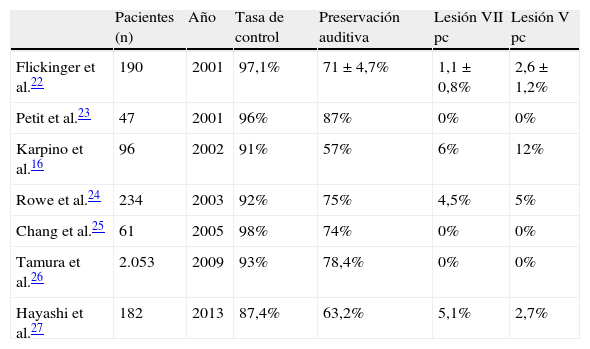El neurinoma del acústico es un tumor benigno que suele afectar a la porción vestibular del viii par craneal. Representan el 8% de todos los tumores intracraneales y el 80% de los que surgen a nivel del ángulo pontocerebeloso. Existen 3 opciones terapéuticas: la microcirugía, que es la técnica de elección, la radiocirugía y la observación. El objetivo del estudio ha sido valorar los resultados obtenidos con la radiocirugía en el tratamiento del neurinoma del acústico, así como los efectos secundarios derivados del mismo.
Material y métodosHemos realizado en nuestro hospital una revisión de todos los pacientes tratados con radiocirugía (Gamma Knife y LINAC) a dosis de 1.200-1.300 cGy por neurinoma del acústico unilateral, entre enero de 1999 y enero del 2010. En todos los pacientes se valoraron el estado general, la tasa de control de crecimiento tumoral, entendiéndose como tal que no cambia de tamaño o que se reduce, la afectación del v y vii par craneal, así como alteraciones del sistema nervioso central. También el tiempo de seguimiento y las variaciones de los umbrales auditivos tras la radiocirugía.
ResultadosDe un total de 35 pacientes estudiados, con una edad media de 58,29 años y sin diferencias estadísticamente significativas en cuanto al sexo, la tasa de control de crecimiento tumoral fue superior al 90%. El principal motivo de consulta (65,71%) fue la hipoacusia unilateral y progresiva. Un 34,28% de los pacientes tratados presentaron empeoramiento en su nivel de audición postratamiento. La afectación de los pares craneales (v-vii) en el 100% de los casos fue transitoria. La radiocirugía tipo Gamma Knife fue administrada en la mayoría de los pacientes (82,85%).
ConclusiónAunque la microcirugía sigue siendo el tratamiento de elección para los neurinomas del acústico, consideramos la radiocirugía como una alternativa válida en pacientes seleccionados (edad avanzada, comorbilidad asociada, pequeño tamaño e hipoacusia neurosensorial, entre otros).
The acoustic neuroma is a benign tumour that usually affects the vestibular portion of the vestibulocochlear nerve. It represents 8% of all intracranial tumours and 80% of those arising at the cerebellopontine angle. There are 3 treatment options: microsurgery (the technique of choice), radiosurgery and observation. The objective of the study was to evaluate the results and side effects obtained using radiosurgery as treatment for acoustic neuroma.
Material and methodsWe performed a review of all patients treated with radiosurgery (Gamma Knife and linear accelerator) at doses of 1200-1300 cGy for unilateral acoustic neuroma in our hospital from January 1999 until January 2010. In all patients we evaluated the overall state, tumour growth control rate (tumour smaller or remaining the same size), the involvement of v and vii cranial nerves and central nervous system disorders. We also assessed follow-up time and changes in hearing thresholds after radiosurgery.
ResultsFrom a total of 35 patients studied, with a mean age of 58.29 years and lacking statistically significant differences in gender, the tumour growth control rate was over 90%. The main reason for visit (65.71%) was unilateral and progressive hearing loss. After treatment, 34.28% of patients had hearing loss. The involvement of the cranial nerves (v-vii) was transitory in 100% of cases. Gamma Knife radiosurgery was administered in 82.85% of patients.
ConclusionAlthough microsurgery is the treatment of choice for acoustic neuroma, we consider radiosurgery as a valid alternative in selected patients (elderly, comorbidity, small tumour size and sensorineural hearing loss, among others).
Artículo
Comprando el artículo el PDF del mismo podrá ser descargado
Precio 19,34 €
Comprar ahora








